Comprehensive Report: Patient Safety and Handling Post-Hip Replacement
VerifiedAdded on 2023/06/10
|7
|1491
|312
Report
AI Summary
This nursing assignment addresses the critical aspects of patient safety and manual handling following a total hip replacement, specifically focusing on an obese patient, Mrs. Smith. It identifies potential hazards such as dislocation and back injuries associated with manual lifting and discusses risk factors related to the patient's condition. The assignment highlights the importance of health and safety management in healthcare organizations, emphasizing the roles of OSHA and HSE in risk assessment and minimization. It also explores relevant policies and procedures, including the Work Health and Safety Act and Safe Patient Handling policies. Furthermore, the report suggests strategies to reduce manual patient handling risks, such as promoting patient mobility and using mechanical aids like inflatable lifting aids. The assignment underscores the significance of workplace safety meetings, incident reporting, and addressing stress and fatigue among healthcare workers to ensure a safe working environment and prevent adverse events. Debriefing sessions are also emphasized as a tool for continuous improvement and enhanced accountability.
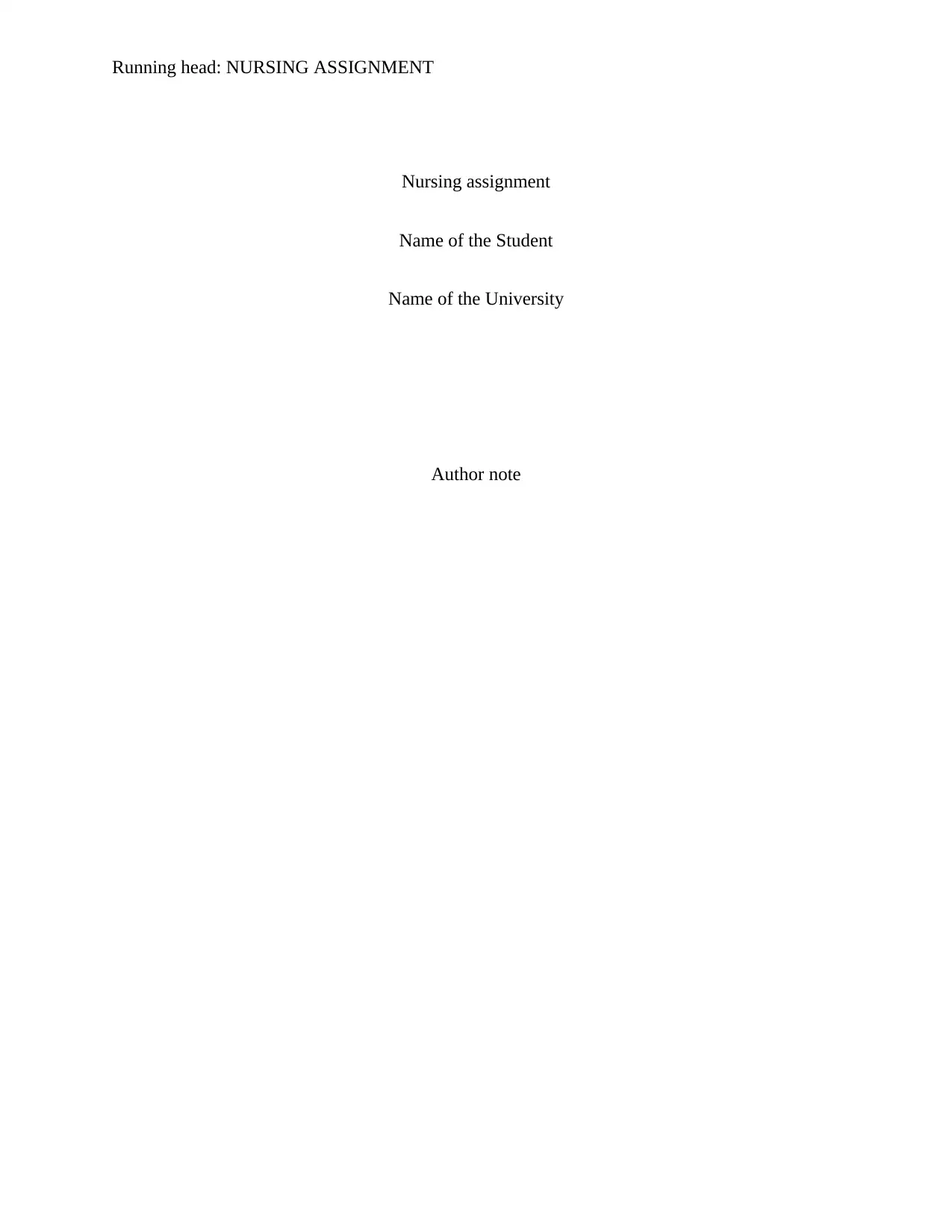
Running head: NURSING ASSIGNMENT
Nursing assignment
Name of the Student
Name of the University
Author note
Nursing assignment
Name of the Student
Name of the University
Author note
Paraphrase This Document
Need a fresh take? Get an instant paraphrase of this document with our AI Paraphraser
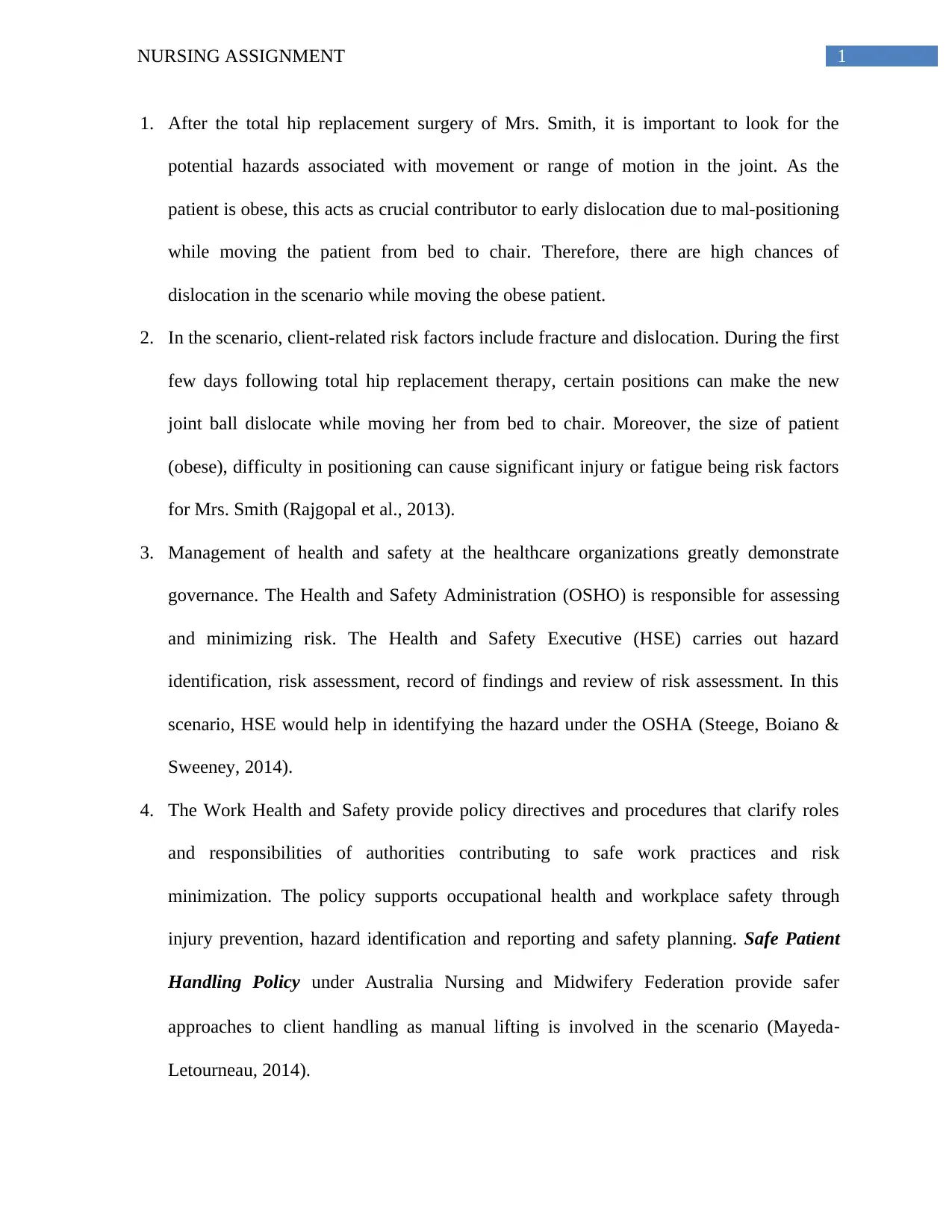
1NURSING ASSIGNMENT
1. After the total hip replacement surgery of Mrs. Smith, it is important to look for the
potential hazards associated with movement or range of motion in the joint. As the
patient is obese, this acts as crucial contributor to early dislocation due to mal-positioning
while moving the patient from bed to chair. Therefore, there are high chances of
dislocation in the scenario while moving the obese patient.
2. In the scenario, client-related risk factors include fracture and dislocation. During the first
few days following total hip replacement therapy, certain positions can make the new
joint ball dislocate while moving her from bed to chair. Moreover, the size of patient
(obese), difficulty in positioning can cause significant injury or fatigue being risk factors
for Mrs. Smith (Rajgopal et al., 2013).
3. Management of health and safety at the healthcare organizations greatly demonstrate
governance. The Health and Safety Administration (OSHO) is responsible for assessing
and minimizing risk. The Health and Safety Executive (HSE) carries out hazard
identification, risk assessment, record of findings and review of risk assessment. In this
scenario, HSE would help in identifying the hazard under the OSHA (Steege, Boiano &
Sweeney, 2014).
4. The Work Health and Safety provide policy directives and procedures that clarify roles
and responsibilities of authorities contributing to safe work practices and risk
minimization. The policy supports occupational health and workplace safety through
injury prevention, hazard identification and reporting and safety planning. Safe Patient
Handling Policy under Australia Nursing and Midwifery Federation provide safer
approaches to client handling as manual lifting is involved in the scenario (Mayeda‐
Letourneau, 2014).
1. After the total hip replacement surgery of Mrs. Smith, it is important to look for the
potential hazards associated with movement or range of motion in the joint. As the
patient is obese, this acts as crucial contributor to early dislocation due to mal-positioning
while moving the patient from bed to chair. Therefore, there are high chances of
dislocation in the scenario while moving the obese patient.
2. In the scenario, client-related risk factors include fracture and dislocation. During the first
few days following total hip replacement therapy, certain positions can make the new
joint ball dislocate while moving her from bed to chair. Moreover, the size of patient
(obese), difficulty in positioning can cause significant injury or fatigue being risk factors
for Mrs. Smith (Rajgopal et al., 2013).
3. Management of health and safety at the healthcare organizations greatly demonstrate
governance. The Health and Safety Administration (OSHO) is responsible for assessing
and minimizing risk. The Health and Safety Executive (HSE) carries out hazard
identification, risk assessment, record of findings and review of risk assessment. In this
scenario, HSE would help in identifying the hazard under the OSHA (Steege, Boiano &
Sweeney, 2014).
4. The Work Health and Safety provide policy directives and procedures that clarify roles
and responsibilities of authorities contributing to safe work practices and risk
minimization. The policy supports occupational health and workplace safety through
injury prevention, hazard identification and reporting and safety planning. Safe Patient
Handling Policy under Australia Nursing and Midwifery Federation provide safer
approaches to client handling as manual lifting is involved in the scenario (Mayeda‐
Letourneau, 2014).
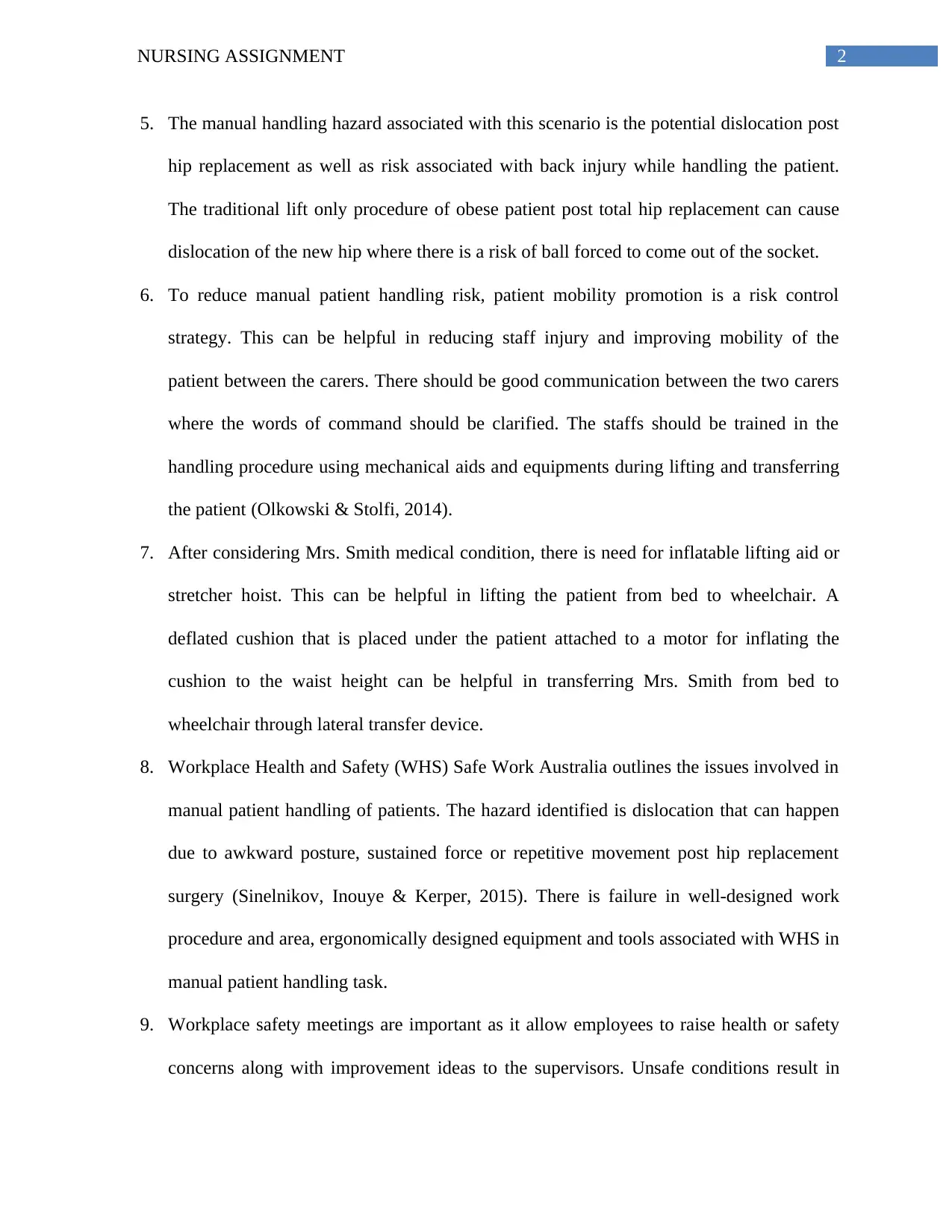
2NURSING ASSIGNMENT
5. The manual handling hazard associated with this scenario is the potential dislocation post
hip replacement as well as risk associated with back injury while handling the patient.
The traditional lift only procedure of obese patient post total hip replacement can cause
dislocation of the new hip where there is a risk of ball forced to come out of the socket.
6. To reduce manual patient handling risk, patient mobility promotion is a risk control
strategy. This can be helpful in reducing staff injury and improving mobility of the
patient between the carers. There should be good communication between the two carers
where the words of command should be clarified. The staffs should be trained in the
handling procedure using mechanical aids and equipments during lifting and transferring
the patient (Olkowski & Stolfi, 2014).
7. After considering Mrs. Smith medical condition, there is need for inflatable lifting aid or
stretcher hoist. This can be helpful in lifting the patient from bed to wheelchair. A
deflated cushion that is placed under the patient attached to a motor for inflating the
cushion to the waist height can be helpful in transferring Mrs. Smith from bed to
wheelchair through lateral transfer device.
8. Workplace Health and Safety (WHS) Safe Work Australia outlines the issues involved in
manual patient handling of patients. The hazard identified is dislocation that can happen
due to awkward posture, sustained force or repetitive movement post hip replacement
surgery (Sinelnikov, Inouye & Kerper, 2015). There is failure in well-designed work
procedure and area, ergonomically designed equipment and tools associated with WHS in
manual patient handling task.
9. Workplace safety meetings are important as it allow employees to raise health or safety
concerns along with improvement ideas to the supervisors. Unsafe conditions result in
5. The manual handling hazard associated with this scenario is the potential dislocation post
hip replacement as well as risk associated with back injury while handling the patient.
The traditional lift only procedure of obese patient post total hip replacement can cause
dislocation of the new hip where there is a risk of ball forced to come out of the socket.
6. To reduce manual patient handling risk, patient mobility promotion is a risk control
strategy. This can be helpful in reducing staff injury and improving mobility of the
patient between the carers. There should be good communication between the two carers
where the words of command should be clarified. The staffs should be trained in the
handling procedure using mechanical aids and equipments during lifting and transferring
the patient (Olkowski & Stolfi, 2014).
7. After considering Mrs. Smith medical condition, there is need for inflatable lifting aid or
stretcher hoist. This can be helpful in lifting the patient from bed to wheelchair. A
deflated cushion that is placed under the patient attached to a motor for inflating the
cushion to the waist height can be helpful in transferring Mrs. Smith from bed to
wheelchair through lateral transfer device.
8. Workplace Health and Safety (WHS) Safe Work Australia outlines the issues involved in
manual patient handling of patients. The hazard identified is dislocation that can happen
due to awkward posture, sustained force or repetitive movement post hip replacement
surgery (Sinelnikov, Inouye & Kerper, 2015). There is failure in well-designed work
procedure and area, ergonomically designed equipment and tools associated with WHS in
manual patient handling task.
9. Workplace safety meetings are important as it allow employees to raise health or safety
concerns along with improvement ideas to the supervisors. Unsafe conditions result in
⊘ This is a preview!⊘
Do you want full access?
Subscribe today to unlock all pages.

Trusted by 1+ million students worldwide
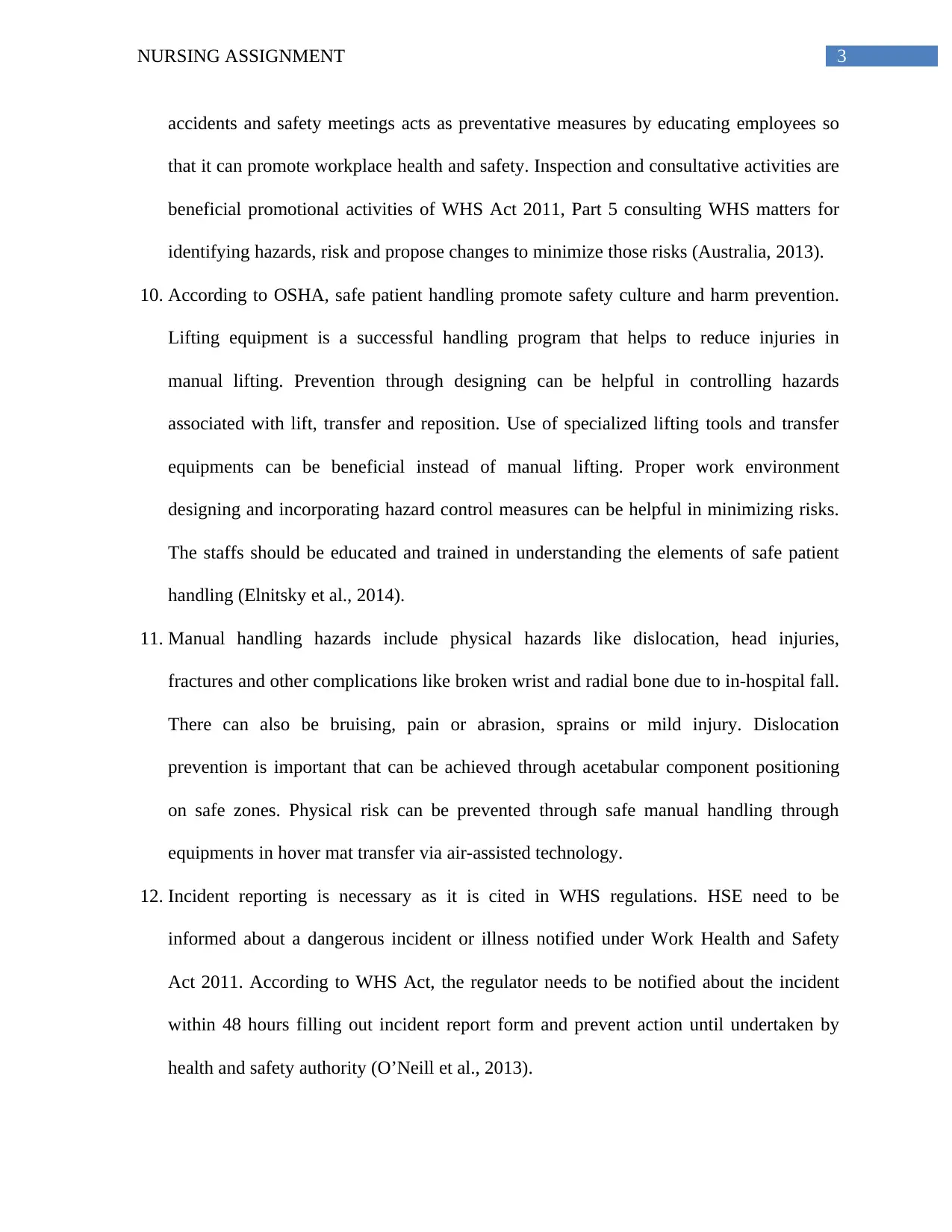
3NURSING ASSIGNMENT
accidents and safety meetings acts as preventative measures by educating employees so
that it can promote workplace health and safety. Inspection and consultative activities are
beneficial promotional activities of WHS Act 2011, Part 5 consulting WHS matters for
identifying hazards, risk and propose changes to minimize those risks (Australia, 2013).
10. According to OSHA, safe patient handling promote safety culture and harm prevention.
Lifting equipment is a successful handling program that helps to reduce injuries in
manual lifting. Prevention through designing can be helpful in controlling hazards
associated with lift, transfer and reposition. Use of specialized lifting tools and transfer
equipments can be beneficial instead of manual lifting. Proper work environment
designing and incorporating hazard control measures can be helpful in minimizing risks.
The staffs should be educated and trained in understanding the elements of safe patient
handling (Elnitsky et al., 2014).
11. Manual handling hazards include physical hazards like dislocation, head injuries,
fractures and other complications like broken wrist and radial bone due to in-hospital fall.
There can also be bruising, pain or abrasion, sprains or mild injury. Dislocation
prevention is important that can be achieved through acetabular component positioning
on safe zones. Physical risk can be prevented through safe manual handling through
equipments in hover mat transfer via air-assisted technology.
12. Incident reporting is necessary as it is cited in WHS regulations. HSE need to be
informed about a dangerous incident or illness notified under Work Health and Safety
Act 2011. According to WHS Act, the regulator needs to be notified about the incident
within 48 hours filling out incident report form and prevent action until undertaken by
health and safety authority (O’Neill et al., 2013).
accidents and safety meetings acts as preventative measures by educating employees so
that it can promote workplace health and safety. Inspection and consultative activities are
beneficial promotional activities of WHS Act 2011, Part 5 consulting WHS matters for
identifying hazards, risk and propose changes to minimize those risks (Australia, 2013).
10. According to OSHA, safe patient handling promote safety culture and harm prevention.
Lifting equipment is a successful handling program that helps to reduce injuries in
manual lifting. Prevention through designing can be helpful in controlling hazards
associated with lift, transfer and reposition. Use of specialized lifting tools and transfer
equipments can be beneficial instead of manual lifting. Proper work environment
designing and incorporating hazard control measures can be helpful in minimizing risks.
The staffs should be educated and trained in understanding the elements of safe patient
handling (Elnitsky et al., 2014).
11. Manual handling hazards include physical hazards like dislocation, head injuries,
fractures and other complications like broken wrist and radial bone due to in-hospital fall.
There can also be bruising, pain or abrasion, sprains or mild injury. Dislocation
prevention is important that can be achieved through acetabular component positioning
on safe zones. Physical risk can be prevented through safe manual handling through
equipments in hover mat transfer via air-assisted technology.
12. Incident reporting is necessary as it is cited in WHS regulations. HSE need to be
informed about a dangerous incident or illness notified under Work Health and Safety
Act 2011. According to WHS Act, the regulator needs to be notified about the incident
within 48 hours filling out incident report form and prevent action until undertaken by
health and safety authority (O’Neill et al., 2013).
Paraphrase This Document
Need a fresh take? Get an instant paraphrase of this document with our AI Paraphraser
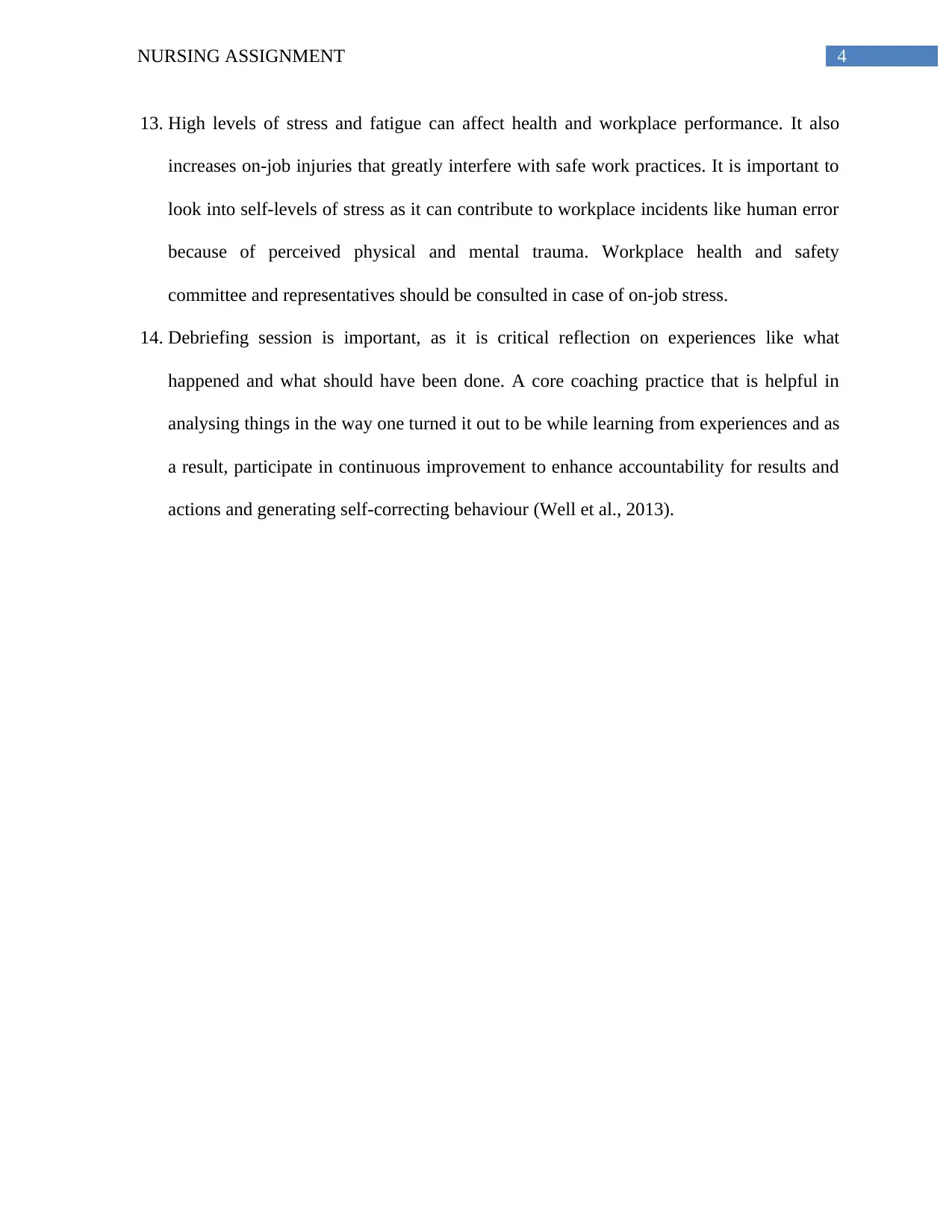
4NURSING ASSIGNMENT
13. High levels of stress and fatigue can affect health and workplace performance. It also
increases on-job injuries that greatly interfere with safe work practices. It is important to
look into self-levels of stress as it can contribute to workplace incidents like human error
because of perceived physical and mental trauma. Workplace health and safety
committee and representatives should be consulted in case of on-job stress.
14. Debriefing session is important, as it is critical reflection on experiences like what
happened and what should have been done. A core coaching practice that is helpful in
analysing things in the way one turned it out to be while learning from experiences and as
a result, participate in continuous improvement to enhance accountability for results and
actions and generating self-correcting behaviour (Well et al., 2013).
13. High levels of stress and fatigue can affect health and workplace performance. It also
increases on-job injuries that greatly interfere with safe work practices. It is important to
look into self-levels of stress as it can contribute to workplace incidents like human error
because of perceived physical and mental trauma. Workplace health and safety
committee and representatives should be consulted in case of on-job stress.
14. Debriefing session is important, as it is critical reflection on experiences like what
happened and what should have been done. A core coaching practice that is helpful in
analysing things in the way one turned it out to be while learning from experiences and as
a result, participate in continuous improvement to enhance accountability for results and
actions and generating self-correcting behaviour (Well et al., 2013).
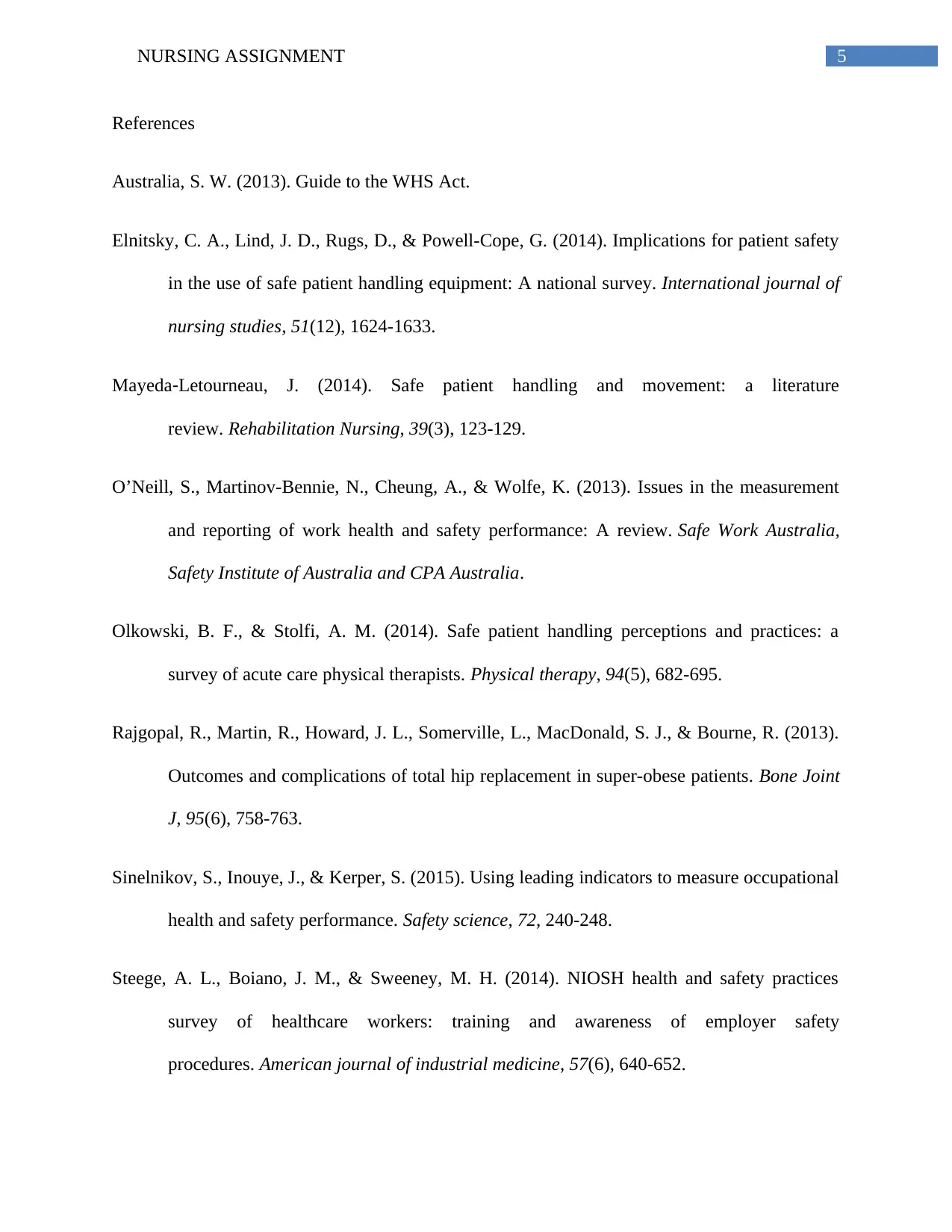
5NURSING ASSIGNMENT
References
Australia, S. W. (2013). Guide to the WHS Act.
Elnitsky, C. A., Lind, J. D., Rugs, D., & Powell-Cope, G. (2014). Implications for patient safety
in the use of safe patient handling equipment: A national survey. International journal of
nursing studies, 51(12), 1624-1633.
Mayeda‐Letourneau, J. (2014). Safe patient handling and movement: a literature
review. Rehabilitation Nursing, 39(3), 123-129.
O’Neill, S., Martinov-Bennie, N., Cheung, A., & Wolfe, K. (2013). Issues in the measurement
and reporting of work health and safety performance: A review. Safe Work Australia,
Safety Institute of Australia and CPA Australia.
Olkowski, B. F., & Stolfi, A. M. (2014). Safe patient handling perceptions and practices: a
survey of acute care physical therapists. Physical therapy, 94(5), 682-695.
Rajgopal, R., Martin, R., Howard, J. L., Somerville, L., MacDonald, S. J., & Bourne, R. (2013).
Outcomes and complications of total hip replacement in super-obese patients. Bone Joint
J, 95(6), 758-763.
Sinelnikov, S., Inouye, J., & Kerper, S. (2015). Using leading indicators to measure occupational
health and safety performance. Safety science, 72, 240-248.
Steege, A. L., Boiano, J. M., & Sweeney, M. H. (2014). NIOSH health and safety practices
survey of healthcare workers: training and awareness of employer safety
procedures. American journal of industrial medicine, 57(6), 640-652.
References
Australia, S. W. (2013). Guide to the WHS Act.
Elnitsky, C. A., Lind, J. D., Rugs, D., & Powell-Cope, G. (2014). Implications for patient safety
in the use of safe patient handling equipment: A national survey. International journal of
nursing studies, 51(12), 1624-1633.
Mayeda‐Letourneau, J. (2014). Safe patient handling and movement: a literature
review. Rehabilitation Nursing, 39(3), 123-129.
O’Neill, S., Martinov-Bennie, N., Cheung, A., & Wolfe, K. (2013). Issues in the measurement
and reporting of work health and safety performance: A review. Safe Work Australia,
Safety Institute of Australia and CPA Australia.
Olkowski, B. F., & Stolfi, A. M. (2014). Safe patient handling perceptions and practices: a
survey of acute care physical therapists. Physical therapy, 94(5), 682-695.
Rajgopal, R., Martin, R., Howard, J. L., Somerville, L., MacDonald, S. J., & Bourne, R. (2013).
Outcomes and complications of total hip replacement in super-obese patients. Bone Joint
J, 95(6), 758-763.
Sinelnikov, S., Inouye, J., & Kerper, S. (2015). Using leading indicators to measure occupational
health and safety performance. Safety science, 72, 240-248.
Steege, A. L., Boiano, J. M., & Sweeney, M. H. (2014). NIOSH health and safety practices
survey of healthcare workers: training and awareness of employer safety
procedures. American journal of industrial medicine, 57(6), 640-652.
⊘ This is a preview!⊘
Do you want full access?
Subscribe today to unlock all pages.

Trusted by 1+ million students worldwide
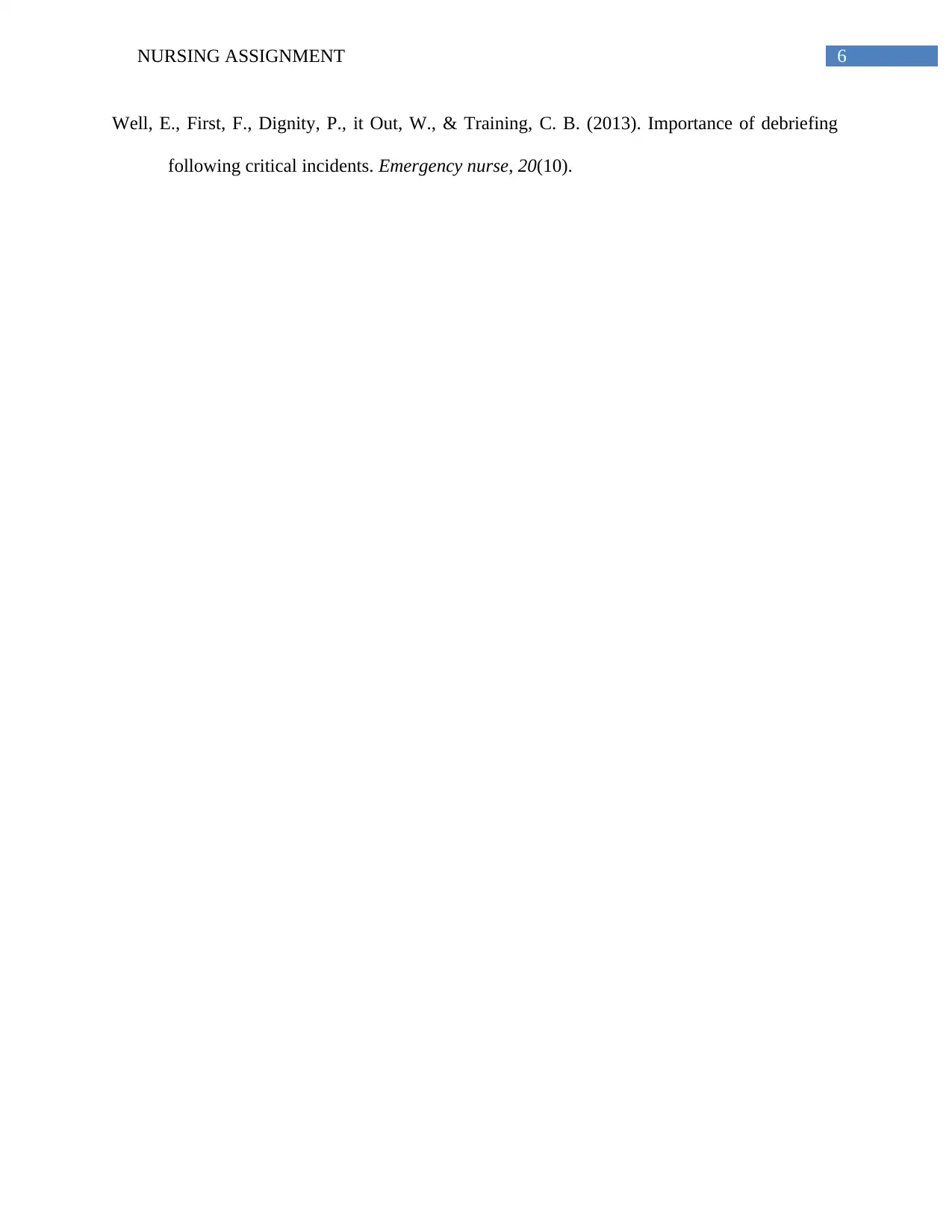
6NURSING ASSIGNMENT
Well, E., First, F., Dignity, P., it Out, W., & Training, C. B. (2013). Importance of debriefing
following critical incidents. Emergency nurse, 20(10).
Well, E., First, F., Dignity, P., it Out, W., & Training, C. B. (2013). Importance of debriefing
following critical incidents. Emergency nurse, 20(10).
1 out of 7
Your All-in-One AI-Powered Toolkit for Academic Success.
+13062052269
info@desklib.com
Available 24*7 on WhatsApp / Email
![[object Object]](/_next/static/media/star-bottom.7253800d.svg)
Unlock your academic potential
Copyright © 2020–2025 A2Z Services. All Rights Reserved. Developed and managed by ZUCOL.


